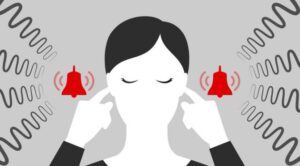Hearing loss can be caused by a number of factors, including exposure to loud sounds. Noiseinduced hearing loss (NIHL), often accompanied by tinnitus (ringing, buzzing, or roaring) may be caused by prolonged exposure to sounds at an unsafe volume (concerts, heavy machinery) or by a one-time exposure to an intense “impulse” sound (explosion, gunshot). Nearly 24% of the adult population have features of their hearing test that suggest hearing loss in one or both ears from noise exposure (NIDCD, 2017).
Sound is measured in decibels. On the decibel scale, an increase of 10 means that a sound is 10 times more powerful, which is perceived as twice as loud to your ear. Prolonged or repeated exposure to sounds at or above 85 decibels can cause hearing loss. The louder the sound, the shorter the time period before NIHL can occur.
SIGNS THAT NOISE IS TOO LOUD:
1.You must raise your voice to be heard.
2.You can’t hear or understand someone feet away from you.
3.Speech around you sounds muffled or dull after you leave a noisy area.
4.You have pain or ringing in your ears after you hear the noise, called tinnitus. It can last a few minutes or a few days (ASHA, 2017).
NIHL is the one type of hearing loss that is completely preventable with the use of hearing protection! There are several options for hearing protection: non-custom ear plugs, custom ear plugs and ear muffs.
The use of double hearing protection at the same time (i.e., ear plugs with ear muffs) is the most effective and safest way to protect your hearing.
It is important to be knowledgeable about hearing protection options so that you can select the right one(s) for your hearing protection needs.
HEARING PROTECTION
There are a wide range of hearing protective devices available in both custom and non-custom styles. The chart below provides an overview of some of the options.
See your Dallas Ear Institute provider for further evaluation.



